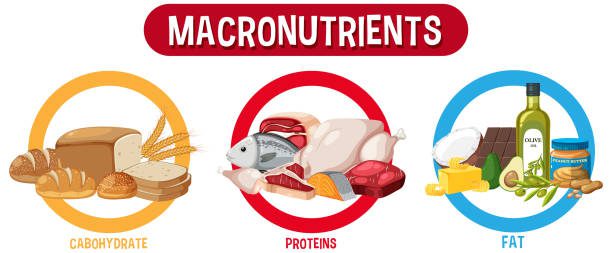This content is for informational and educational purposes only. Always consult a qualified healthcare provider.
Last Updated on February 5, 2024 by Grace Oluchi
Macronutrients are the essential building blocks of a healthy diet! They provide the energy and nutrients your body needs to function at its best! From protein-packed meats to carb-rich grains, macronutrients give you the fuel you need to power through your day! So, if you want to feel great and stay healthy, make sure to get plenty of macronutrients in your diet!
📋 Table of Contents
What are Macronutrients?
Macronutrients are nutrients that the body needs in relatively large quantities to provide energy, support metabolism, and promote growth and repair. The three primary macronutrients are carbohydrates, proteins, and fats.


Carbohydrates are the body’s primary source of energy, while proteins are essential for muscle growth and repair and support a variety of metabolic functions. Fats are an essential component of a healthy diet and provide energy, support hormone production, and aid in the absorption of fat-soluble vitamins. Proper macronutrient balance is essential for optimal health and well-being.
Understanding the Macronutrients on the National Label.
Macronutrients are the essential nutrients that our body needs in large quantities to function properly. These include carbohydrates, proteins, and fats. The National Label is a standardized nutritional labeling system that is mandated by the FDA in the United States. It provides information on the nutritional content of a food item, including the macronutrient composition.
To understand the macronutrients on the National Label, it is important to know where they are located. The macronutrient information is typically listed under the heading “Nutrition Facts” on the product packaging. The label displays the serving size, calories, and the amounts of carbohydrates, proteins, and fats present in the food item.
Carbohydrates are the primary source of energy for our bodies, and they are located under the “Total Carbohydrates” section on the National Label. This section also includes information on fiber and sugars. Proteins are the building blocks of our body and are listed under the “Protein” section. Fats are essential for proper brain function and are located under the “Total Fat” section. This section also includes information on saturated and trans fats.
It is important to note that the macronutrient composition can vary greatly depending on the food item. For example, a piece of fruit may have a high carbohydrate content, while a piece of meat may have a high protein content. It is crucial to read the nutritional label carefully to understand the macronutrient composition of the food item you are consuming.
Understanding the macronutrients on the National Label is crucial for making informed decisions about the food we consume. By knowing where to find the macronutrient information on the label, we can make healthier choices that support our overall health and well-being.
Decoding the Nutrition Facts: Macronutrient Location.
The Nutrition Facts label is an essential tool for individuals to make informed decisions about the food they eat. It provides critical information about the nutritional content of a food item, including the macronutrient composition. However, understanding the location of macronutrients on the label can be confusing. Here’s a breakdown of the macronutrient location on the Nutrition Facts label.
Carbohydrates, proteins, and fats are the three macronutrients that make up the majority of our diet. Carbohydrates are the primary source of energy for the body, while proteins and fats are critical for cellular function. The macronutrient information is typically displayed in grams and as a percentage of the daily value (DV) on the label.
The carbohydrates section lists the total amount of carbohydrates per serving, including dietary fiber and sugars. The protein section lists the total amount of protein per serving. The fats section lists the total amount of fat per serving, including saturated and trans fats.
It is also important to note that the macronutrient composition can vary greatly between different food items. For example, one serving of cereal may have a high carbohydrate content, while one serving of chicken may have a high protein content.
To make informed decisions about the food we eat, it is crucial to understand the macronutrient composition of the food item. By reading the Nutrition Facts label carefully, we can identify the macronutrient content of the food item and make better choices that support our overall health and well-being.
Decoding the macronutrient location on the Nutrition Facts label is crucial for making informed decisions about the food we consume. By understanding the macronutrient composition of the food item, we can make healthier choices that support our overall health and well-being.
Finding Macronutrients on the National Label: A Guide.
The National Label is a standardized nutritional labeling system that provides information on the nutritional content of a food item, including the macronutrient composition. However, finding the macronutrients on the label can be challenging for some individuals. Here’s a guide to help you find the macronutrients on the National Label.
The macronutrient information is typically located under the “Nutrition Facts” section on the product packaging. The label displays the serving size, calories, and the amounts of carbohydrates, proteins, and fats present in the food item. Here’s a breakdown of the macronutrient location on the National Label:
- Carbohydrates: The total amount of carbohydrates present in the food item is typically listed under the “Total Carbohydrates” section. This section also includes information on dietary fiber and sugars.
- Proteins: The total amount of protein present in the food item is typically listed under the “Protein” section.
- Fats: The total amount of fat present in the food item is typically listed under the “Total Fat” section. This section also includes information on saturated and trans fats.
It is important to note that the macronutrient composition can vary greatly depending on the food item. A piece of fruit may have a high carbohydrate content. A piece of meat may have a high protein content. It is crucial to read the nutritional label carefully to understand the macronutrient composition of the food item you are consuming.
In addition to the macronutrients, the National Label also provides information on other important nutrients, such as vitamins and minerals. These are typically listed under the “Vitamins and Minerals” section.
Finding the macronutrients on the National Label is essential for making informed decisions about the food we consume. By understanding where to find the macronutrient information on the label, we can make healthier choices that support our overall health and well-being.
The Importance of Tracking Macronutrients for Health and Fitness Goals.
Macronutrients, including carbohydrates, proteins, and fats, are essential components of a healthy diet. They provide the body with energy, support metabolism, and aid in muscle growth and repair. Tracking macronutrients can be a useful tool for individuals looking to achieve specific health and fitness goals. Here’s why tracking macronutrients is essential for achieving health and fitness goals.
- Helps Maintain a Balanced Diet: Tracking macronutrients can help individuals ensure they are consuming a balanced diet that includes all the essential macronutrients in the right proportions. This can help prevent nutrient deficiencies and promote overall health.
- Aids in Weight Loss: Tracking macronutrients can help individuals lose weight by ensuring they are consuming fewer calories than they burn. By tracking macronutrient intake, individuals can ensure they are consuming the right balance of macronutrients to support their weight loss goals.
- Supports Muscle Growth and Repair: Consuming the right balance of macronutrients is critical for muscle growth and repair. Tracking macronutrient intake can help individuals ensure they are consuming enough protein to support muscle growth and repair.
- Helps Manage Chronic Conditions: Tracking macronutrients can be beneficial for individuals with chronic conditions such as diabetes or cardiovascular disease. By tracking macronutrient intake, individuals can ensure they are consuming the right balance of macronutrients to support their condition.
It is essential to note that tracking macronutrients requires a level of dedication and effort. It involves keeping track of the macronutrient content of the food consumed and ensuring that the intake aligns with one’s health and fitness goals. However, there are several apps and tools available that can make tracking macronutrients easier.
Tracking macronutrients is essential for individuals looking to achieve specific health and fitness goals. It can help maintain a balanced diet, aid in weight loss, support muscle growth and repair, and manage chronic conditions. By tracking macronutrient intake, individuals can make informed decisions about the food they consume, promoting overall health and well-being.
Understanding Macronutrient Timing for Optimal Performance.
Macronutrient timing refers to the strategic consumption of carbohydrates, proteins, and fats before, during, and after exercise to maximize performance and recovery. Proper macronutrient timing can help athletes and fitness enthusiasts achieve their goals and reach their full potential. Here’s a breakdown of macronutrient timing and how it can optimize performance.
- Pre-Workout Nutrition: Consuming carbohydrates and proteins before exercise can provide the body with the energy it needs to perform at its best. Carbohydrates provide immediate energy, while proteins help prevent muscle breakdown and support muscle growth.
- During Workout Nutrition: Consuming carbohydrates and electrolytes during exercise can help maintain energy levels and prevent dehydration. Consuming carbohydrates in the form of sports drinks, gels, or bars can provide a quick source of energy during prolonged exercise.
- Post-Workout Nutrition: Consuming carbohydrates and proteins after exercise is crucial for recovery and muscle growth. Consuming carbohydrates after exercise can help replenish glycogen stores, while proteins help repair and rebuild muscle tissue.
It is essential to note that macronutrient timing can vary depending on the type of exercise and the individual’s goals. For example, endurance athletes may require more carbohydrates during exercise, while strength athletes may require more protein after exercise.
In addition to macronutrient timing, it is crucial to consider the quality and quantity of macronutrients consumed. Consuming high-quality, nutrient-dense foods can provide the body with the necessary nutrients to support optimal performance and recovery.
Understanding macronutrient timing is essential for athletes and fitness enthusiasts looking to optimize their performance and achieve their goals. Proper macronutrient timing can provide the body with the necessary energy and nutrients to perform at its best, prevent muscle breakdown, and support muscle growth and recovery. By strategically consuming carbohydrates, proteins, and fats before, during, and after exercise, individuals can reach their full potential and achieve their health and fitness goals.
The Key Takeaway.
Macronutrients are essential nutrients that the body needs in large quantities to provide energy, support metabolism, and promote growth and repair. The three primary macronutrients are carbohydrates, proteins, and fats, and a proper balance of these nutrients is necessary for optimal health and well-being.
What are macronutrients?
Macronutrients are nutrients that the body needs in large quantities to function properly. There are three main macronutrients: carbohydrates, proteins, and fats.
What is the role of carbohydrates in the body?
Carbohydrates are the body’s primary source of energy. They are broken down into glucose, which is used by the body for fuel. Carbohydrates also play a role in brain function and digestion.
What is the role of proteins in the body?
Proteins are essential for building and repairing tissues in the body, such as muscle tissue. They also play a role in hormone production, enzyme production, and immune function.
What is the role of fats in the body?
Fats are important for energy storage, insulation, and protection of vital organs. They also play a role in hormone production and cell membrane function.
How much of each macronutrient should I consume?
The recommended intake of macronutrients varies depending on a person’s age, sex, weight, and level of physical activity. Generally, carbohydrates should make up 45-65% of daily calorie intake, protein should make up 10-35%, and fats should make up 20-35%. However, it’s important to talk to a healthcare provider or registered dietitian to determine the right macronutrient balance for your individual needs.

